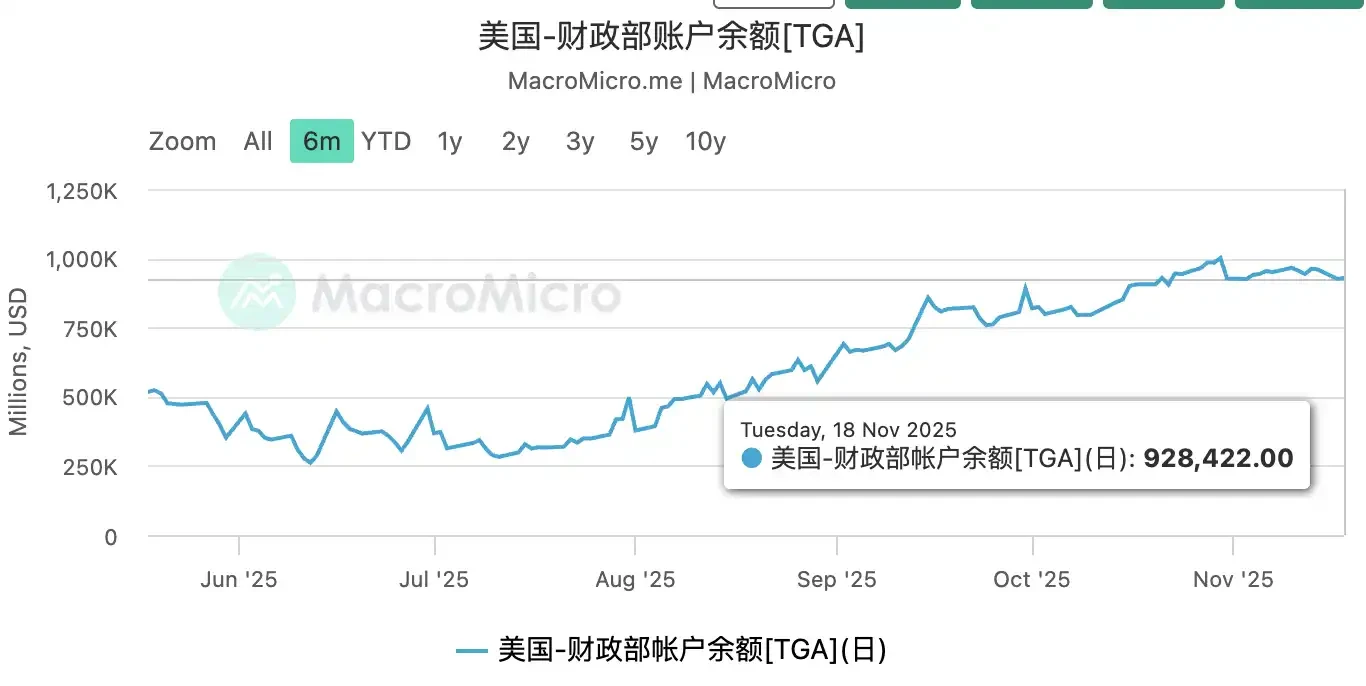Is Bitcoin poised for a breakout? Three key factors for a December price surge.
Nvidia delivered a stellar performance last night.
Nvidia reported third-quarter revenue of $57 billion, a 62% year-over-year surge, and net profit soared 65% to $31.9 billion. This marks the twelfth consecutive time Nvidia has exceeded expectations. Following the earnings release, the stock price jumped 4-6% in after-hours trading and continued to rise 5.1% in pre-market trading the next day, directly adding approximately $22 billion to the company's market capitalization and also boosting Nasdaq futures by 1.5-2%.
Logically, with such positive market sentiment, Bitcoin, the digital gold, should also benefit, right? But reality slapped us in the face—Bitcoin fell instead of rising, with its price dropping to $91,363, a decrease of about 3%.
Nvidia surged, but Bitcoin fell?
Those investors who once regarded Bitcoin as a safe haven are now probably only feeling uneasy.
Initially marketed as a "weapon against inflation" and a "safe haven during times of economic anxiety," it now behaves more like a high-risk tech stock than a safe-haven asset like physical gold.
The data speaks even more bluntly: after a 26% plunge from its all-time high in early October, Bitcoin's price has now essentially returned to its level at the beginning of the year. In other words, the entire year has been a complete waste of time.
Meanwhile, what about real gold? It surged 55% in 2025. The psychological gap for Bitcoin holders is truly enormous.
The factors driving up gold prices are actually quite clear: potential interest rate cuts, a weaker dollar, increased market volatility, and an uncertain economic outlook. Following the traditional logic of Bitcoin, these conditions should also have pushed up Bitcoin's price. But the opposite is true.
CME Group economist Mark Shore pointed out in May that the correlation between Bitcoin and US stocks turned positive in 2020 and has remained so ever since. More importantly, the amount of Bitcoin flowing into institutional investors through ETFs and listed cryptocurrency companies has reached an all-time high over the past year.
In other words, Bitcoin is becoming more and more "mainstream," but at the cost of becoming more and more like a traditional risk asset.
Of course, the reason why "Nvidia surged while Bitcoin fell" also lies in the flow of funds.
Nvidia benefits from the unwavering, certain demand in the AI field. CEO Jensen Huang emphasized the "continued acceleration in computing demand," and the newly launched Blackwell chip saw "explosive" sales, with the visibility of $500 billion in orders directly allaying market concerns about an AI bubble. Hyperscale cloud service providers, such as giants like Amazon and Microsoft, have spent over $380 billion in capital expenditures this year, with the majority of that money flowing to Nvidia.
And Bitcoin? It suffered a full-blown blow from risk aversion. As a "high-beta risk asset," it was the first to be hit in an environment of tightening liquidity. In just one week, it fell by 12.5%. Cryptocurrency ETFs saw a net outflow of $867 million on November 13, as long-term holders began to sell, and the supply of dormant Bitcoin dropped from 8 million at the beginning of the year to 7.32 million.
So what conditions are needed for Bitcoin to rise in price?
While the current situation is not optimistic, it is not without hope. For Bitcoin to take off again, several key conditions may need to be met simultaneously.
Liquidity injection after the US government reopened
The 43-day government shutdown officially ended on November 18. The shutdown affected 1.25 million federal employees, resulting in approximately $16 billion in lost wages and causing consumer confidence to plummet to a three-year low of 50.4.
Now that the government has reopened, injecting liquidity has become crucial.
Here's a concept to explain—the TGA (Treasury General Account), which is the U.S. Treasury's primary operating account at the Federal Reserve. All government revenues and expenditures pass through this account. When the TGA increases, it means funds are flowing from the market to the government, reducing market liquidity; conversely, when the TGA decreases, government spending injects funds into the market, increasing liquidity.
Data shows that from October 1 to November 12, 2025, a period of 43 days, the TGA balance continued to accumulate, reaching a high of $959 billion on November 14. This level is far higher than the cash position that the Treasury usually maintains, mainly because spending was restricted during the government shutdown, coupled with continuous debt issuance to raise funds, resulting in a large accumulation of cash in the Treasury account.

Currently, TGA data does not show a significant decline.
Based on the estimated reopening date of November 13, 2025, and drawing on historical experience, it is expected that in the first week, government employees will receive back pay, with approximately $16 billion flowing into the economy, resulting in a relatively small impact. In other words, it is unlikely that a large influx of liquidity will occur before November 20th.
In another 1-2 weeks, around the beginning of December, TGA will normalize its operation, daily government spending will resume, tax revenue will seasonally return, and TGA balances will begin to fluctuate and be released in large amounts. Only then will the market begin to feel a significant improvement in liquidity.
Increased interbank liquidity and ample institutional funds mean that Bitcoin, as a risk asset, will also receive capital inflows and experience a price increase.
The experience of early 2019 provides important insights. The US government also experienced a prolonged shutdown, lasting 35 days from December 22, 2018 to January 25, 2019. During the shutdown, the TGA balance also accumulated significantly, reaching $413 billion on January 29, 2019. When the government resumed operations, the Treasury Department rapidly increased spending, and within just one month from January 29 to March 1, the TGA balance decreased by $211 billion. These funds flowed into the financial system, significantly improving liquidity. This drove the stock market and Bitcoin up by 8.5% and 35% respectively within 30 days of reopening.
Compared to the current situation, the Treasury's general account (TGA) balance will reach $959 billion in November 2025, far exceeding the $413 billion in 2019, which means that the potential scale of liquidity release is even more considerable.
Federal Reserve policy shift
Speaking of the Federal Reserve, it is another major force influencing the direction of Bitcoin.
The latest Federal Reserve meeting minutes reveal a significant division among officials regarding the need for a third consecutive interest rate cut. Most officials believed further rate cuts could exacerbate inflation risks. White House economic advisor Hassett even admitted that they had "lost control of inflation."
Trump once again erupted in "impotent rage," directly attacking Federal Reserve Chairman Powell, saying he "want to fire him, he's extremely incompetent."
According to CME's "FedWatch," the probability of a 25 basis point rate cut in December is only 36.2%, while the probability of keeping rates unchanged is as high as 63.8%.
Worse still, the U.S. Bureau of Labor Statistics has confirmed that household data for October (used to calculate key statistics such as the unemployment rate) could not be collected retroactively, and therefore will not be released in the October jobs report. Instead, this non-farm payroll data will be included in the November jobs report, which will be released on December 16. This means the Federal Reserve will not have access to crucial employment data at its final meeting of the year.
Furthermore, the rise in US Treasury yields, with yields across major maturities generally increasing, including a 2.5 basis point increase in the 10-year yield, has largely dashed market expectations for a December rate cut, with the probability of such a cut falling to around 31%.
However, if we take a longer-term view, the situation may not be so pessimistic. The delayed November employment data will be released on December 16th, and if the data is weak, it could still support expectations for another round of interest rate cuts, around January 27th next year. Currently, the probability of a rate cut appears to be 48%, the highest among the meetings scheduled for 2026.
Looking at the bigger picture, while the Federal Reserve's stance is ambiguous, other major, more dovish central banks around the world are already taking action. This undercurrent could be a significant driver of Bitcoin's price increase.
For example, the European Central Bank (ECB) is currently maintaining its deposit facility rate at 2.00%, but there is a high probability of a 25 basis point rate cut in December, as inflation has fallen to 2.1%, close to its target level. Here's an interesting statistic: historically, ECB rate cuts have had a correlation of up to 0.85 with Bitcoin price increases. Why? Because loose liquidity in the Eurozone spills over into global markets, boosting overall risk appetite.
The economy has improved significantly.
The current US economy presents a very delicate situation—with both bright spots and hidden worries.
The trade deficit narrowed sharply in August, falling 23.8% to $59.6 billion, exceeding market expectations of $61 billion. This was mainly due to a 6.6% decrease in goods imports as a result of tariffs. This change is expected to contribute 1.5-2.0 percentage points to third-quarter GDP growth, pushing the growth forecast to 3.8%. Sounds good, right? But the problem is that this improvement comes at the expense of imports, which could impact supply chains and consumption in the long run.
Although the 43-day government shutdown has ended, its damage continues. $16 billion in lost wages, a consumer confidence index plummeting to a three-year low of 50.4, and the CBO projecting a 1.5 percentage point loss in fourth-quarter GDP—these figures reflect real economic pain.
Food inflation is also a key factor; what used to cost $100 now costs $250, and the quality is worse. Just as the egg price surge was subsiding, beef, a favorite among Americans, is now facing new inflation.
The latest Consumer Price Index (CPI) released on October 24 showed that the prices of roast beef and steak rose by 18.4% and 16.6% year-on-year, respectively. According to data from the U.S. Department of Agriculture, the retail price of ground beef has surged to $6.10 per pound, a record high. Compared to three years ago, beef prices have increased by more than 50%.
In addition, coffee prices rose 18.9%, natural gas prices rose 11.7%, electricity prices rose 5.1%, and car repair costs rose 11.5%. Many young Americans burdened with debt from college are facing even greater pressure due to the further increase in the cost of living.
The "warning sign of a K-shaped economy" is perhaps the most worrying trend in the current US economic situation. Nearly 25% of American households are living paycheck to paycheck, wage growth for low-income groups has stagnated, while high-income groups (accounting for 50% of consumption) continue to benefit from AI investment. The risk of economic polarization is rising sharply.
Furthermore, tariff policies continue to drag down global export economies, with Japan, Switzerland, and Mexico all experiencing contractions in the third quarter. This ripple effect on the global economy will ultimately reach the US market, impacting investor risk appetite.
However, if the US government can improve the US economy, then various assets, including Bitcoin, will have the opportunity to rise.
Institutional funds return
If the previous conditions are the "right time," then institutional funding is the "right people." This is probably the most direct and immediate catalyst.
It has to be said that the current data is not very good. From November 13th to 19th, ETFs saw a net outflow of $2 billion (approximately 20,000 Bitcoins), the largest weekly outflow since February of this year. Currently, assets under management (AUM) stand at $122.3 billion, representing 6.6% of Bitcoin's total market capitalization.
What does this mean? Institutional investors are withdrawing, and at a rapid pace.
Given the current macroeconomic environment, institutional funds are facing multiple pressures: First, there is a severe liquidity stratification. The technology/AI sector has received ample funding, traditional safe-haven assets like gold have performed strongly, while liquidity in purely risky assets like cryptocurrencies is drying up. The money hasn't disappeared; it's just gone elsewhere.
Moreover, the typical behavior patterns of institutional investors and fund managers are often shaped by an incentive structure that encourages them to "avoid making mistakes." The industry's evaluation system focuses more on "not falling behind peers" than on "whether excess returns have been achieved." Within this framework, the cost of taking risks that contradict mainstream views often far outweighs the potential returns.
Therefore, most fund managers tend to maintain a portfolio structure consistent with mainstream market allocations. For example, if Bitcoin experiences a general correction, and a fund manager still maintains a significant long position, the drawdown will be amplified and interpreted as a "misjudgment," resulting in far more criticism than the recognition that would come with equivalent gains. Ultimately, under such institutional constraints, "conservatism" becomes a rational choice.
But history tells us that institutional fund flows often reverse suddenly at a certain critical point. So where is this critical point? There are three clear signals:
Signal 1: Net inflow for 3 consecutive days
This is the most important signal. Historical data shows that when ETF fund flows turn positive and maintain net inflows for three consecutive days, Bitcoin will rise by 60-70% on average within 60-100 days.
Why is it so magical? Because institutional investment is the sector where the "herd effect" is most pronounced. Once the trend reverses, subsequent funds will follow like dominoes. This is how the market rally in early 2024 started.
Signal 2: Daily inflows exceeding $500 million
This signals the entry of large institutions. In October 2024, a single-week inflow of $3.24 billion directly propelled Bitcoin to a new all-time high. That kind of momentum is simply impossible for retail investors to achieve.
What does $500 million in a single day mean? It's equivalent to giants like BlackRock and Fidelity simultaneously deciding to increase their holdings. This level of capital inflow is often accompanied by clear macroeconomic judgments—they see signals that ordinary investors cannot.
Signal 3: AUM ratio rebounds to above 8%
Currently, Bitcoin's total assets under management (AUM) of $122.3 billion represent 6.6% of its market capitalization, a historically low level. At its peak in 2024, this percentage reached 8-9%. The fact that this percentage is starting to rise indicates that institutions are not only buying Bitcoin, but are doing so at a rate that exceeds the rate of price increases.
So, under what circumstances will institutional funds flow back?
Basically, as mentioned earlier: the Federal Reserve has given clear signals of interest rate cuts; US economic data has become clearer; coordinated easing by global central banks has created a resonance; and key resistance levels have been broken through technically.
Potential time for price increases
After discussing so many conditions, what everyone is probably most concerned about is: when will the price actually rise?
While no one can accurately predict the market, we can identify several key milestones based on the timeline of macroeconomic events.
December 10: FOMC Meeting
This is the last Federal Reserve meeting of the year and the most closely watched event by the market.
If interest rates are indeed cut, Bitcoin may experience a surge; if not, it may experience another drop.
Here's a key point: even without a rate cut, if the Federal Reserve releases dovish signals (such as emphasizing "maintaining flexibility" and "closely monitoring employment data"), it will support market sentiment. Conversely, if it doesn't cut rates and adopts a hawkish stance, then be prepared for short-term pressure.
December 16: Delayed November employment data
This data will include the full picture for October and November, confirming the true trends in the labor market.
If data remains weak for two consecutive months, the probability of an interest rate cut in early 2026 will increase significantly. This would provide medium-term support for Bitcoin. If the data is confusing or contradictory, the market may remain indecisive, and the range-bound trading pattern may continue.
The data release is highly certain, but the quality of the data itself may be unreliable (government shutdowns lead to statistical chaos), so market reactions may be more based on interpretation than on the data itself.
Late December to the end of the year: The "traditional peak season" for liquidity.
This is an interesting seasonal pattern. Historically, institutional investors conduct year-end rebalancing from late December to the New Year, and the reduced trading volume during the holidays amplifies price volatility.
If the aforementioned events combine to create a positive synergy, a "Christmas rally" may occur at the end of the year. However, we should also be wary of the "sell the news" effect—profit-taking after the positive news has been priced in.
First Quarter of 2026: A Grand Strategy of Synchronized Global Liquidity Easing
This is the time window with the most room for imagination.
If the Federal Reserve cuts interest rates in December or January, and the European Central Bank and the People's Bank of China continue their accommodative policies, a synchronized improvement in global liquidity will occur. In this scenario, Bitcoin could see a repeat of the surge seen in 2020—when it rose from a low of $3,800 in March to $28,000 by the end of the year, an increase of over 600%.
Of course, it is unlikely that 2026 will completely replicate 2020 (when the stimulus from the pandemic was unprecedented), but the combination of coordinated easing by global central banks, the release of TGA funds, and the return of institutional funds will be enough to drive a decent market rally.
The likelihood of synchronized global liquidity easing is moderately high (60-65%). Central banks around the world are facing pressure from economic slowdown, making easing a highly probable event.
- 核心观点:比特币与美股正相关,风险属性增强。
- 关键要素:
- 英伟达财报亮眼,比特币却下跌3%。
- 比特币与美股相关性自2020年转正。
- 机构ETF资金净流出20亿美元。
- 市场影响:比特币避险属性减弱,风险偏好主导。
- 时效性标注:中期影响



